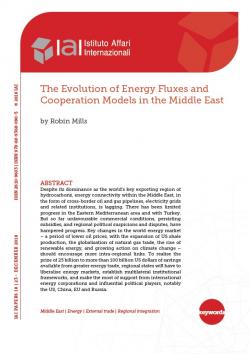The Evolution of Energy Fluxes and Cooperation Models in the Middle East
Despite its dominance as the world’s key exporting region of hydrocarbons, energy connectivity within the Middle East, in the form of cross-border oil and gas pipelines, electricity grids and related institutions, is lagging. There has been limited progress in the Eastern Mediterranean area and with Turkey. But so far unfavourable commercial conditions, persisting subsidies, and regional political suspicions and disputes, have hampered progress. Key changes in the world energy market – a period of lower oil prices, with the expansion of US shale production, the globalisation of natural gas trade, the rise of renewable energy, and growing action on climate change – should encourage more intra-regional links. To realise the prize of 25 billion to more than 100 billion US dollars of savings available from greater energy trade, regional states will have to liberalise energy markets, establish multilateral institutional frameworks, and make the most of support from international energy corporations and influential political players, notably the US, China, EU and Russia.
Paper prepared in the framework of the IAI-Eni Strategic Partnership, December 2018.
-
Details
Rome, IAI, December 2018, 17 p. -
In:
-
Issue
18|23 -
ISBN/ISSN/DOI:
978-88-9368-090-5
Introduction
1. The history of Middle East energy trade
1.1 The shape of Middle East energy trade
1.2 The Gulf
1.3 Iraq and its neighbours
1.4 The Levant
2. Opportunities and challenges for further cooperation
2.1 Oil and gas
2.2 Electricity and renewables
3. The political, geopolitical and geoeconomic drivers
3.1 Institutions and politics
3.2 The wider context: the BRI and other players
Conclusions
References
Topic
Tag
Related content
-
Ricerca02/11/2018
IAI-Eni Strategic Partnership
leggi tutto



